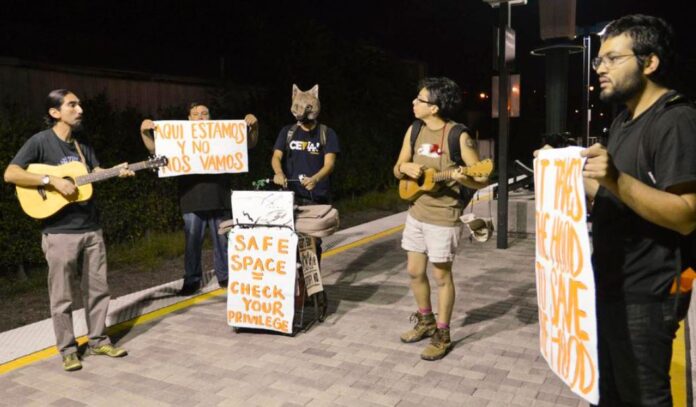
The American Prospect, by Carribean Fragoza, July 4, 2018.
In the escalating battle against gentrification in Los Angeles, artists and activists appear to stand on opposite sides. As Los Angeles extends its reach as a global art center, its economic disparities have spread as well. The city’s current housing crisis has uprooted thousands of families and accelerated homelessness. According to the Los Angeles Times,homelessness rose by a whopping 75 percent in the last six years.
However, a closer look reveals that while some artists build lucrative careers, others walk away from their aspirations to support L.A.’s most vulnerable communities. In the process, they are re-inventing their roles as artists as well as their approaches to art-making as they challenge profit-driven arts establishments and exploitative real-estate and housing markets.
Lincoln Heights, which is experiencing the vigorous redevelopment and displacement of gentrification, is where you’ll find Arturo Romo. For Romo, making art in a community is akin to watering a garden. “It’s a way to belong to a place, not to own it,” he says.
Romo focuses on continuing to make art privately in his studio, as well as collectively with the people who live in his community. “The market has done harm to us as humans by reducing arts to a profession,” he says. “The role of artists in society is misconceived because it separates artists from any community and sets them into a category of their own.”
Romo also sees his work with the North East Los Angeles Alliance (NELAA) in Highland Park as an important way to engage in arts-centered community activism. The neighborhood-based arts group first gained attention in 2014 when it placed eviction notices on gentrifying businesses in Highland Park, sparking anti-gentrification protests similar to movements in Boyle Heights and other areas.
Example: The NELAA artists organized community workshops and curated an exhibition at a local art gallery, which they eventually dismantled and reconstructed into a giant serpent puppet that they danced through Highland Park streets to the Marmion Royal complex. This demonstration helped launch weeks of protests by the tenants, who eventually took their case to court.
Artists are learning new ways to extend themselves well beyond typical art circles to confront the politics of gentrification and take direct grassroots action. “ Now there are so many types of artists working in a lot of directions,” says de la Loza. “There’s a growing body of people questioning what is an artist and what [do] we produce.”
Analysis: This article was a good reminder that artists are often also leading grassroots actions against gentrification. In my research, I am finding two avenues of discussion: one about artists causing gentrification, and another about them fighting to destroy it. Artists have a lot at stake in de-gentrifying, including the reduction of gallery spaces that might sell their works (if they successfuly de-gentrify). Their artworks are not the only way they can intervene, they can also do so through organizing. This article also gives me a jumping-off point for finding more organizations that are working to de-gentrify L.A.



